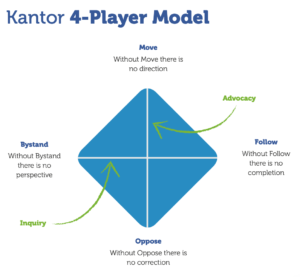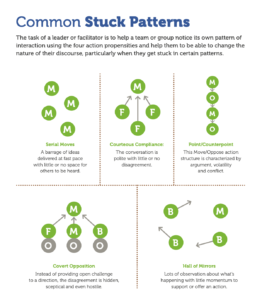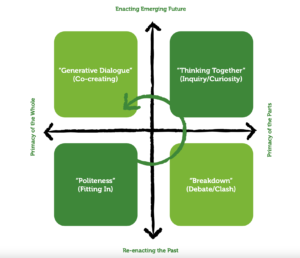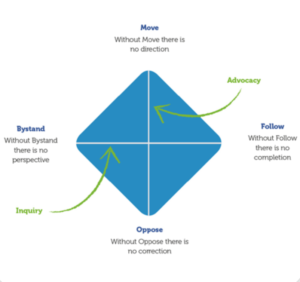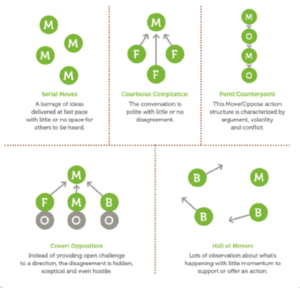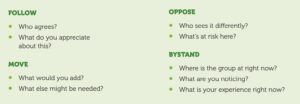Leaders lead companies, boards, teams, groups, cohorts.
In other words, leaders lead… people.
How do leaders do it? How do leaders connect to and stay connected with the people they lead?
Keep on reading!
1 Listening, Not to React, But to Hear
Leaders should be curious. They should listen with intent to hear, not to respond and react to what is being said.
How do you do this?
Intentional listening is a skill that involves suspending judgment while focusing on the person who is talking, giving them undivided attention. Intentional listening is a way of listening to understand what is being said.
Learn more about international listening and curiosity here.
2 Dare to Dialogue
Leaders, I challenge you. Dare to dialogue.
Having real conversations with real people is a leadership skill.
“In dialogue, like in debate, you can have a perspective, but your viewpoint doesn’t guide the conversation. In fact, in dialogue you suspend your point of view, not only to hear the other’s perspective, but to ask them more about it. This is the space of curiosity and inquiry and listening without resistance, because this is where new thinking and innovation live.”
Dialogue is where leaders gain greater insight and agility.
3 Shared Common Interests
The art of being with other human beings requires you to be human. That means showing up as a human and being willing to share that side of you with your team.
Leaders inspire by doing, by leading, by setting the right example.
If you are active on LinkedIn, you will know what I mean. There are so many wonderful leadership stories on LinkedIn these days, great examples of how leaders share common interests, and are showing up for their teams.
4 Body Language
While in 2022 more and more people are working from home, and meetings are often conducted behind a screen, body language continues to be an important tool for leaders to connect with the people on their team.
Sitting behind screens vs being in the same room, makes reading body language a bit more complicated.
In this recent article about hybrid meetings, we emphasized the need for the meeting facilitator to recognize the importance of the webcam!
“As the facilitator, you will have some specific requests for participants in order to make the session the most effective. Be sure to share these, along with other logistics and joining information, with participants ahead of time.”
- One camera, one mic, one mouse per person
- Be on camera
- Be off mute
- Be prepared to be called on
Whether you meet with the team you lead in person, virtually or in a hybrid form, being able to read body language is of utmost importance.
Why?
This “7-38-5 rule” states that 7 percent of meaning is communicated through spoken word, 38 percent through tone of voice, and 55 percent through body language. This 7-38-55 rule was developed by psychology professor Albert Mehrabian at the University of California, Los Angeles, who laid out the concept in his 1971 book Silent Messages (1971).
5 Keeping the Connection
Last but not least, leaders put effort into keeping the connection with their team! Everything you do, including the words you use and the energy you have, matters!
“Early in my career, I worked at a small startup and we had a private chat channel. When the CEO arrived each morning, someone would give a weather report in the chat. It’s cloudy, it’s sunny, it’s stormy, literally what the mood of the CEO was. This weather report informed my plan and others for the day. On sunny days, I knew I could have important conversations that mattered. If the weather was stormy or cloudy, those were the days that I wanted to lay low and go home early if possible. As leaders, you don’t have to have a title to be a leader, but you bring the weather. So, your words, your energy, your tone, all matter. When you are frantically running down the road, too busy to pause and ask questions, you send the message that there’s no space for conversation here.”
Bring the weather, day after day and stay connected to your team by meeting in small groups like Ahmed Sidky did.
Leadership Lessons. A Journey to Agile Team Facilitation
We invite you, the kind of leader who wants to continue on their leadership journey to check our offering of workshops.
In particular, our virtual Agile team Facilitation Workshop touches on many of the leadership lessons mentioned in this article. If you are a team leader, don’t miss this chance to learn to design and lead engaging, purposeful and fun meetings…and achieve results every time.
